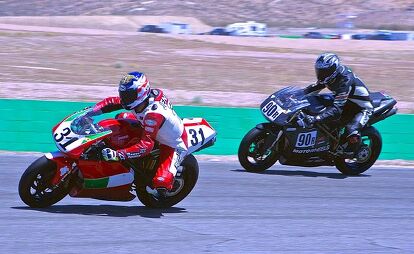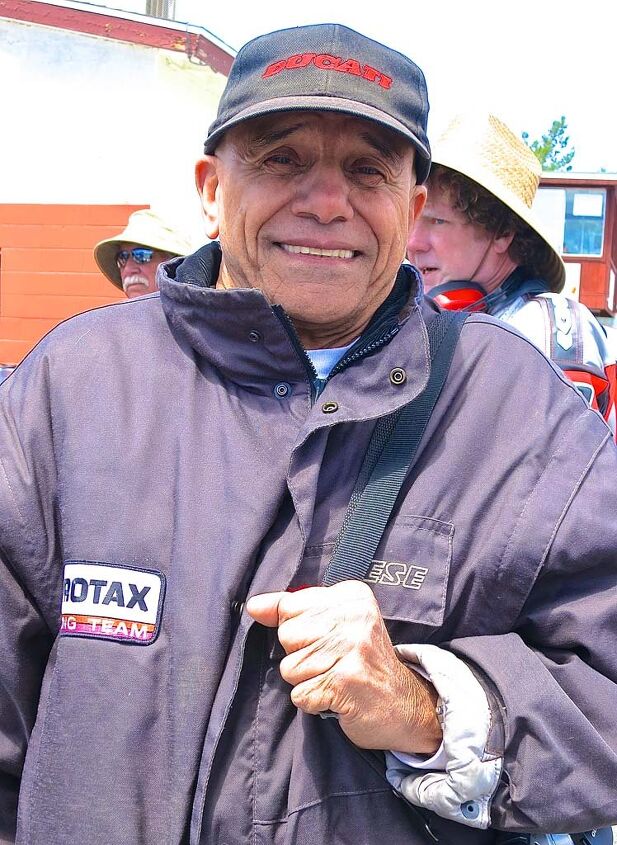AHRMA Moto Corsa Classica

The racers, my friend, are blown' in the wind
There are still, as the late Gordon Jennings once observed, no willows at Willow Springs. Nor any springs. There is, after 61 years in operation, still a fast, challenging, relatively safe and often wind-blown roadracing circuit. Which, for the last 19 years, has hosted the annual Moto Corsa Classica staged by the American Historic Racing Motorcycle Association (AHRMA) and the Garage Company of Inglewood, Calif.
For this April’s event last weekend, “The Fastest Road in the West” was also the windiest. The high desert location north of Los Angeles is known for harsh weather, and a Friday night storm had dumped snow on the surrounding mountains. Racers were greeted by temps in the 40s and corresponding 40-50 mph winds in the morning. The old rationales made the rounds – it is what it is, conditions are the same for everyone … but it still sucked rocks. The forecast for Sunday, on the other hand, was encouraging. A spring of hope.
AHRMA has been on the scene for 25 years, and Roadrace Director Cindy Cowell and Chief Tech Inspector Cal Lewis have the program logistics dialed in. With 40(!) classes, efficiency is key, so it’s morning practice, lunch, races in the afternoon. Many classes are small and run in combined events, bringing the race total to 11.
Vintage roadracing hardly ranks as a high-growth sport in the States, but most riders mark that as an asset. The community remains small and mostly friendly, and both age and economic scales reflect the breadth and depth of like-minded riders. Older and/or wealthier entrants bring out rare and costly examples of racing history, while the more modest of budget ride the best machines they can afford. With so many classes, it’s buy what you can and run what you brung.
The one significant growth factor here is the increase in female riders. Including the sidecars, there were a dozen women on the track for the Classica. Wendy Newton left her Ducati Single at home (“it had issues”), and brought a Honda Ascot and a tidy little WR450F Yamaha built by Roland Sands for Sound of Singles 2. Her first ride was 30 years ago, on a secretly borrowed Vespa, which she got underway and promptly wheelied across the street into the neighbor’s lawn.
After some instruction, a few Harleys and a BMW later, “I was offered a ride on a Triumph Speed Triple, I got that taste of speed and I didn’t want to give it back. Then I bought a Yamaha R6 and went to a cornering school, then started doing track days for about 10 years, and five years, ago I started racing.”
Kerri Kress, recently transplanted from Miami to San Diego, has been riding motocross for years and is now in her second year of roadracing on a Honda CL350. “I’m in Production Lightweight, so I can’t do any modifications at all. This was my first street bike when I was going to school, and now it’s a race bike.”
Kerri, who has her own graphic design business, admits she’s playing catch-up on the mechanical side. “My boyfriend doesn’t want to work on the bike, so I’ve got do it myself. Yep, got my manuals out.”
Dave Roper, multi-time national champion, Isle of Man winner and veteran international vintage motorhead, was entered in two quite different classes. In 350 GP on a ’68 Aermacchi, and in eSuperSport on a Brammo Empulse – that’s e as in Electric. AHRMA added the watt-racers this year as an exhibition class.
“They are hugely different,” he said. “The Brammo does have a gearbox, but it shifts on the left, down for first, the Aermacchi’s on the right, up for first. I never rode a Brammo before yesterday. My initial impression was, it’s not that different, but it took awhile to get used to the big tires and brakes. After a few laps I started to wonder how do I know when to shift? Then I noticed there was a tachometer, ah, that’s how I know.”
You will not hear them coming. But they are coming. Rapidly. Silently. Be not afraid.
Virgil and Jeff Elings aren’t the only father/son team in vintage racing, but could easily claim the most diverse collection of old factory race bikes – Maybe in the world, but for certain in Solvang, Calif.
“I’m entered in 250GP, Formula 250, 500 Premier and Formula 500,” Jeff said. The rare 1968 Paton 500 had been protested for its 4-valve head in Premier, so Elings switched to the Formula 500 class where it was up against more modern two-strokes. He rode the Matchless Single in Premier and won both classes, both days.
“The Paton is a pretty fast bike. It has pretty high gearing, but I have to shut it down on the back straight or I’ll over-rev it. We can’t gear it any higher, the front sprocket is hitting the case.”
“It’s a replica and has electronic ignition, so it’s better than any vintage thing. Which I think is good for the sport. Of course the Matchless and Norton Singles are not originals, the frames, brakes, ignition. They’re running Honda dampers in the forks.”
Absent this year in the Elings pit was the 1938 DKW 350 twin, a supercharged two-stroke. “We finally got it running,” Virgil said. “It’s really sensitive to mixture with the supercharger. We’ve had two-strokes that would run, but not great. That thing, you open the throttle and it zips.”
His demonstration bike for this year’s Classica was a 1955 NSU Rennmax Single, the machine that inspired Soichiro Honda’s dream to compete in international roadracing. He also owns one of the NSU 250cc racing Twins. (For more on Elings’ remarkable collection, go to www.motosolvang.com)
Some riders were sufficiently spooked by the sandblasting gusts to pack it in and go home at the end of the day. By Sunday the wind had subsided and the temperature climbed. Less clothing, more smiles, faster lap times. Motorcyclist magazine’s Ari Henning dropped from first to second on his dad’s ’69 Honda in Sportsman 500, behind Stephen Hipp. Dave Roper also settled for second in eSupersport, behind series sponsor Art Kowitz on another Brammo. And Billy Hamill also slipped to second in both 200 and 250 GP, behind Todd Johnson and Paul Germain respectively.
As you can see, the term Historic is effectively a misnomer in this context. But American Historic Vintage Modern Future Motorcycle Racing Association is rather awkward. Variety, that’s the appeal AHRMA holds for amateur racers of every stripe; the mix of old and new machines, the collaboration of geezers and youngsters, and the chance to compete at any skill level on some of the best tracks in the country.
Nowhere else will you hear the soulful audio mix of a howling BSA Triple, the thunderous counterpoint of a Norton Manx and Matchless G50, the piercing whine of a full-toot two-stroke, and the assorted rhythm sections of small, medium and large modern Singles and Twins. Not to mention the silent interludes of electric racers. Good stuff.
For complete results of the Corsa Moto Classica, and more on AHRMA, visit the website at www.ahrma.org.

More by Tod Rafferty













































































































Comments
Join the conversation
Thanks for the great coverage and awesome photos. This is the most diverse group of motorcycles you will see on a track. The sounds they make (all different - not like today's races) are a treat to hear. People don't know what they're missing.